Noise will be an absolute key area of the flight path consultation and our responses. However, what about air quality and emissions? Will an extra 25,000 flights with the existing two runways bring about any deterioration in air quality?
First some facts and rules:
NO2 (Nitrogen dioxide) is harmful to humans. According to a UK Government study in 2015 “Studies of long-term exposure to NO2 report associations with all-cause, respiratory and cardiovascular mortality, children’s respiratory symptoms and lung function”.
NOx is a generic term for NO and NO2. NO is relatively unstable and will convert to NO2 if exposed to oxygen.
Particulates are harmful to humans. Particulates are tiny particles. Sometimes they are carbon, but they can be tiny particles of metal. Particles are often put into three sizes:
PM10 – these are particles up to 10 micrometres (10 millionths of a metre) in diameter. These are often called course particles. These are legally defined as particulate matter which passes through a size-selective inlet as defined in the reference method for the sampling and measurement of PM10
PM2.5 – these are particles up to 2.5 micrometres in diameter and are often called fine particles. These are legally defined as particulate matter which passes through a size-selective inlet as defined in the reference method for the sampling and measurement of PM2.5. Diesel engines emit a significant amount of PM2.5s
Ultra-Fine Particles do not have a specific legal definition, but scientists consider these to have a diameter of up to 0.1 micrometres or 100 nanometres. They do however come within the legal definition of PM2.5s since they will pass through a PM2.5 inlet or filter. Ultra-Fine Particles are particularly harmful as when emitted there are so many of them and they have a large total area. They are known to get into the blood stream and in recent research by Queen Mary’s University Hospital have been found in the placentas of pregnant women. Dr Miyashita of the Hospital said: “We’ve known for a while that air pollution affects foetal development and can continue to affect babies after birth and throughout their lives. We were interested to see if these effects could be due to pollution particles moving from the mother’s lungs to the placenta. Until now, there has been very little evidence that inhaled particles get into the blood from the lung.”
The EU passed legislation in 2008 requiring air quality to be of a certain standard. This was EU Directive 2008/50. This EU legislation was then adopted by the UK into The Air Quality Standards Regulations 2010. These regulations lay down certain requirements:
- The Government must have ensured that by 2010 with a long-stop date of 2015 that NO2 is limited to 40 micrograms per cubic metre average in a year, PM10s are limited to 40 micrograms per cubic metre average in a year and PM2.5s are limited to 25 micrograms per cubic metre average in a year. In addition:
- The Government must “ensure that all necessary measures not entailing disproportionate costs are taken to ensure that concentrations of PM2.5…..do not exceed the target values specified”. Those target values are reduced from 25 micrograms per cubic metre under a specific duty upon the Government to reduce the national exposure to PM2.5s. That reduction is to 20 micrograms per cubic metre by 2015 and thereafter until 2020 to reach a series of levels depending on pollution concentrations to between 20 and 8.5 micrograms per cubic metre. When the target reduction gets to 8.5 micrograms, the target reduction is zero. In other words the object is to rid the country of these particulates
According to the Kings College air quality group LondonAir, the PM concentrations in all London Boroughs in 2016 failed to meet the reduction requirements. The projection is that the boroughs of Richmond, Wandsworth, Hounslow and Hillingdon will improve but all be above 13 micrograms per cubic metre of PM2.5s in 2020 rather than the target of 8.5 micrograms. NO2 is no better. In 2013, updated in 2016, Hillingdon had substantial breaches. By 2020 Heathrow and its surrounding areas are still forecast to breach. Heathrow itself is forecast to still be in breach of the NO2 limit in 2030 – and that is with 2 runways. Heathrow has stated in the past that it does not consider that it is bound by the air quality targets within the airport boundary as it is private land.
So; will a third runway detract from the steady improvement in air quality? According to Heathrow, emissions from planes do not contribute notably to emissions once the plane is above 1,000’. They have produced an illustration for their modelling to both members of the Community Noise Forum and to Parliament in evidence to the Transport Committee illustrated as follows: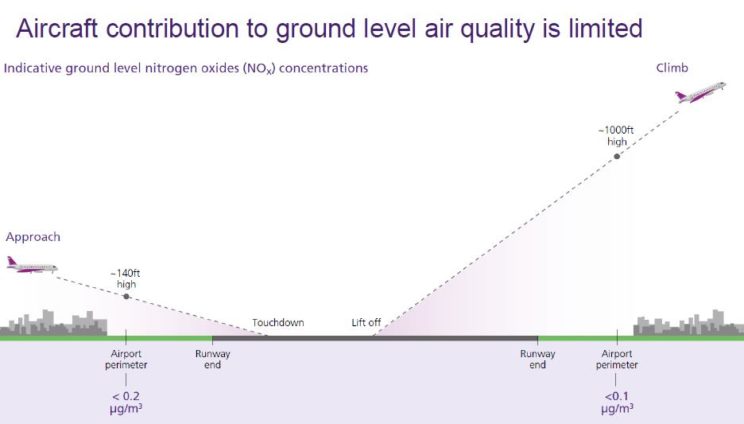
The view of Heathrow is supported by the Government. Sir Howard Davies and the Airports Commission’s advisors, Jacobs, set a study area of just 2 kilometres from the expanded airport boundary. The Government Appraisal of Sustainability carried out by WSP of Exeter expressly followed the study area of Jacobs keeping it to 2 kilometres from the boundary.
Is this right though?
Empirical evidence would suggest that it is not right and that planes emit significant amounts of NO2 and particulates, which find their way down to the ground (and by definition into humans and living creatures as well as vegetation). The DfT deny this but the empirical evidence does not support the DfT.
Studies between 2014 and 2016 at Los Angeles, Atlanta and Schiphol, Amsterdam, strongly suggest otherwise. Mobile monitors set up under the inward flight paths show that particulates and NO2 are transmitted by the wind up to some 20 kilometres down wind. Illustrations in the 2014 research paper of Los Angeles show the elevated levels taken which follow the wind direction:
Layout of Los Angeles Airport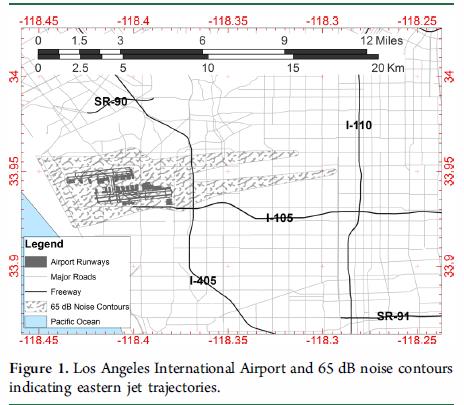
Particulates measured by the mobile monitor having travelled downwind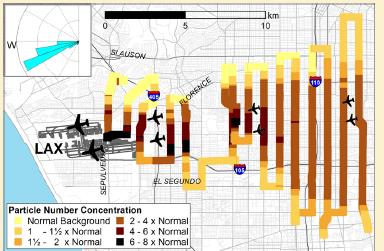
Particulates shown downwind in various directions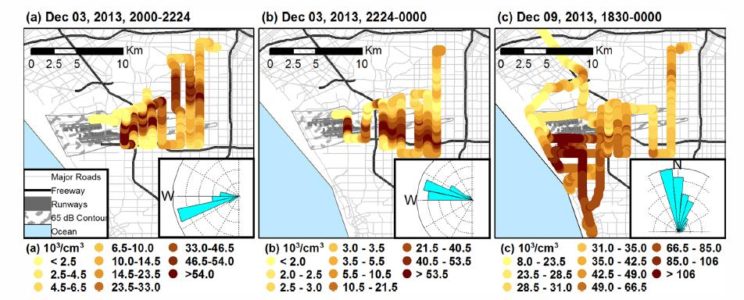
NO2 measured well beyond 2 kilometres from the airport boundary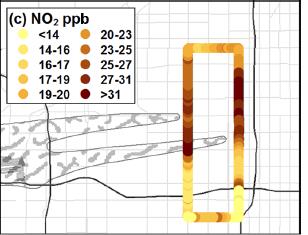
The text of the Los Angeles research states, amongst other things, that:
“The size of the impacted areas with high PN concentration increases was remarkable. At 16 km downwind, a 2-fold increase in PN concentration over baseline concentrations was measured across 6.5 km. Assuming a trapezoidal shaped plume with parallel edges of length 1.5 and 6.5 km, PN concentrations were at least doubled over an area of 60 km2. Eight km downwind, a 5-fold increase in PN concentrations over baseline concentrations extended across 3 km and covered a total area of 24 km2. (Concentrations in this large area exceeded 71,000 particles/cm3, the average concentration on Los Angeles freeways.14) Within 3 km of the airport boundary, concentrations were elevated nearly 10- fold, exceeding 100,000 particles/cm3, with concentrations of 150,000 particles/cm3 occurring over a several km2 area.”
We know from the recent news the terrible impact of poor air quality upon vulnerable people like asthma suffers. Should we have increases in pollution from planes – not to mention the land vehicles that will be going to and from an expanded airport?
Do the Government know of this research? The Air Quality Expert Group reporting to the Department for Environment, Food and Rural Affairs in 2018 state that:
“More recently, Riley et al. (2016) measured downwind of two large airports in the USA: LAX and Hartsfield-Jackson International Airport (ATL – Atlanta, GA), using a mobile monitoring platform. Riley et al. (2016) found a 3–5-fold increase in UFP concentrations in transects under the landing approach path to both airports, relative to surrounding urban areas with similar ground traffic characteristics. The measurements therefore suggest that aircraft plumes mix downwards to a sufficient extent to be detected at ground-level at concentrations similar in magnitude to road vehicle sources. The implications of this work are potentially important for exposure to UFP concentrations. For example, a location such as Heathrow Airport, where aircraft tend to approach the airport from the east (flying over the London conurbation), there is potential for considerable exposure to UFP from aircraft”.
The short answer is that the Government do know of this research.
The record of the Government in bringing air quality up to standard is atrocious. Mr Justice Cranston said, when giving judgment in the third ClientEarth case on whether the Government had produced a satisfactory Air Quality Program:
“It is now eight years since compliance with the 2008 Directive should have been achieved. This is the third, unsuccessful, attempt the Government has made at devising an AQP [Air Quality Program] which complies with the Directive and the domestic Regulations. Each successful challenge has been mounted by a small charity, for which the costs of such litigation constitute a significant challenge. In the meanwhile, UK citizens have been exposed to significant health risks.”
References
Hudda et al. Emissions from an International Airport Increase Particle Number Concentrations 4‑fold at 10 km Downwind – study at Los Angeles 2014 https://www.ncbi.nlm.nih.gov/pmc/articles/PMC4215878/
Keuken et al. Total and size-resolved particle number and black carbon concentrations in urban areas near Schiphol airport (the Netherlands) 2016 https://www.sciencedirect.com/science/article/pii/S1352231015000175
Riley et al. Ultrafine particle size as a tracer for aircraft turbine emissions 2016. https://www.sciencedirect.com/science/article/pii/S135223101630348X
Defra Air Quality Expert Group, Ultrafine Particles (UFP) in the UK 2018 https://uk-air.defra.gov.uk/assets/documents/reports/cat09/1807261113_180703_UFP_Report_FINAL_for_publication.pdf

Have you or are you considering making further measurements
I live in Kingston KT2 area very close to Richmond Park. I nor my immediate neighbours have not received the leaflet in the post regarding the proposed increase.
I look forward to being updated..